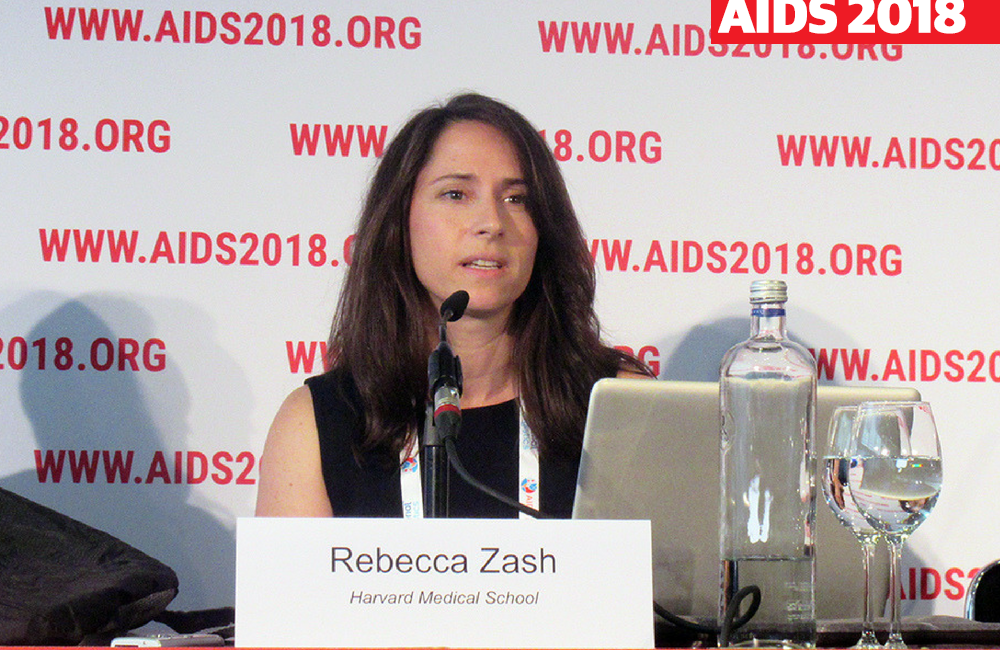
Dolutegravir treatment at the time of conception is associated with a higher risk of neural tube defects in infants exposed to the drug when compared to efavirenz, a study of births to women living with HIV in Botswana has shown. Rebecca Zash of Beth Israel Deaconess Medical Center, Boston, stressed that the results are a preliminary safety signal and require further follow-up.
The findings from the Botswana surveillance study, released in May, led to safety warnings by the European Medicines Agency and the US Food and Drug Administration. The agencies warned that women living with HIV who can become pregnant should not use the integrase inhibitor dolutegravir (Tivicay, also in Triumeq and Juluca) without effective contraception. Subsequent World Health Organization (WHO) treatment guidelines, released yesterday, stress the importance of consistent and reliable contraception if women of childbearing potential opt to take the drug.
The warning has caused controversy over the balance between the risks and benefits of dolutegravir-based treatment for women living with HIV and stalled plans to introduce dolutegravir-based treatment in some countries in sub-Saharan Africa.
Further details of the Botswana surveillance study were presented at the 22nd International AIDS Conference (AIDS 2018) on Tuesday by Dr Rebecca Zash on behalf of the Tsepamo study team. The Tsepamo surveillance study looked at birth outcomes at eight government hospitals in Botswana between August 2014 and May 2018 and covered around 45% of all babies delivered during the period.
The study was originally designed to collect information about birth outcomes in women who took antiretroviral therapy (ART) at the time of conception and during pregnancy. It was able to collect information about birth outcomes in women exposed to efavirenz, to dolutegravir or to protease inhibitor-based regimens. Tsepamo began in 2014 when efavirenz-based ART was the preferred option for first-line treatment and Botswana had just begun a treat-all policy. In 2016, Botswana switched to a first-line regime of dolutegravir, tenofovir and lamivudine for all adults.
A new analysis, looking at women who started dolutegravir-based treatment or another antiretroviral regimen prior to conception, was conducted in 2018 in preparation for the development of new WHO treatment guidelines.
This analysis looked specifically at neural tube defects. A neural tube defect occurs when the spinal cord, brain, and related structures do not form properly. The neural tube develops between 2 and 8 weeks of gestation. Spina bifida – a malformed spinal cord – is the most common neural tube defect. The most common cause of neural tube defects is lack of folic acid during pregnancy but defects can also be caused by some medications. The risk of neural tube defects is highest at the time of conception and in the first trimester of pregnancy, so it is important to rule out any harmful effects of drugs taken at this time.
Researchers compared birth outcomes in women exposed to dolutegravir at the time of conception, women exposed to efavirenz-based ART at the time of conception, women taking other ART regimens at the time of conception, women who started dolutegravir during pregnancy and in HIV-negative women.
The surveillance study has previously reported that women who started dolutegravir during pregnancy did not have an elevated risk of an adverse birth outcome (stillbirth, preterm birth, small for gestational age or neonatal death) compared to women who started efavirenz.
A total of 89,064 births were captured in this surveillance study for neural tube defects (426 in women taking dolutegravir, 5787 in women taking efavirenz and 5513 taking another antiretroviral regimen at the time of conception).
After delivery, 99.7% of infants underwent a physical examination by a midwife to check for neural tube defects. Midwives reported 86 cases (an incidence of 0.10%, 95% CI 0.08-0.12%), of which 42 were spina bifida (incomplete development of the spine leading to protrusion of the neural tube through vertebrae). The remainder were more severe defects affecting the brain and skull. Twenty-two of 86 cases occurred in stillborn infants.
The prevalence of neural tube defects was higher in infants born to women exposed to dolutegravir at the time of conception compared to women exposed to efavirenz or other regimens. Four cases occurred in women taking dolutegravir at the time of conception; none was taking folate supplements prior to pregnancy. No neural tube defects were identified in infants born to women who started dolutegravir treatment during pregnancy.
The prevalence of neural tube defects was 0.94% (95% CI 0.37-2.4%) in women exposed to dolutegravir at conception compared to a prevalence of 0.12% (95% CI 0.07-0.21%) in women exposed to any ART regimen not containing dolutegravir at conception, a risk difference of 0.82%. The prevalence of neural tube defects in women exposed to efavirenz at the time of conception was 0.05% (95% CI 0.02-0.05%) and in HIV-negative women the prevalence was 0.09% (0.07-0.12%).
Potential impact of avoiding dolutegravir
The news of a potential safety problem and the subsequent guidance from regulatory agencies and WHO has caused some ministries of health in lower- and middle-income countries to pause in their plans to implement dolutegravir-based treatment as the preferred first-line treatment, Meg Doherty of WHO told a symposium organised to discuss the results of the Tsepamo study.
Seven countries have already decided not to offer dolutegravir to women of childbearing age and six countries have decided to allow women to take dolutegravir only if they are using contraception.
However, a modelling study presented by Caitlin Dugdale of Massachusetts General Hospital shows that avoiding the use of dolutegravir in women of childbearing age carries risks for women, children and their partners that might outweigh the risk of neural tube defects.
Using a well-tested model of the South African HIV epidemic and treatment patterns in South Africa (the CEPAC model), Dugdale and colleagues looked at the impact on mortality, sexual transmission, vertical transmission and adverse birth outcomes of using either a dolutegravir- or an efavirenz-based regimen over the next five years in 3.5 million women who will be on treatment (1.8 million starting treatment over this period). The model also looked at the impact of the two regimens on 1.1 million children projected to be born to women on antiretroviral treatment.
Assuming dolutegravir is more effective than efavirenz in suppressing viral load and assuming that neural tube defects occur at a similar prevalence to that reported in the Tsepamo study and other studies of efavirenz, dolutegravir would save 28,400 more adult lives than efavirenz, prevent 52,800 more cases of sexual transmission and prevent 5000 more infant infections than efavirenz, the model found.
But efavirenz-based treatment would avert 10,000 more neural tube defects in infants and 8400 more paediatric deaths than dolutegravir, leaving 5400 more infants alive and HIV-free than dolutegravir.
The model was sensitive to assumptions about fertility, treatment efficacy and the prevalence of neural tube defects, meaning that further surveillance data will help to fine-tune the projections.
The findings highlight the trade-offs inherent in making decisions about the most appropriate first-line regimen, especially in countries with large treatment programmes and high fertility rates.
But, as Maggie Little of Georgetown University commented at the end of the symposium, “Policy may not be the right locus for determining acceptable trade-offs in this case; policy may be about supporting meaningful choice for women.” This view was echoed in an eloquent overview of the issues from the perspectives of women living with HIV by Martha Akello of the International Community of Women Living with HIV.
“We want to exercise choice,” she said. “This is not a 'one dress fits all' situation!”
Dugdale C et al. Risks and benefits of dolutegravir (DTG)-based ART for women living with HIV of childbearing age in South Africa: A model-based analysis. 22nd International AIDS Conference (AIDS 2018), Amsterdam, symposium presentation (Safety of Dolutegravir in pregnancy), 2018.
Zash R et al. Surveillance for neural tube defects following antiretroviral exposure from conception. 22nd International AIDS Conference (AIDS 2018), Amsterdam, symposium presentation (Safety of Dolutegravir in pregnancy), 2018.
Download the presentation slides from the AIDS 2018 website.


